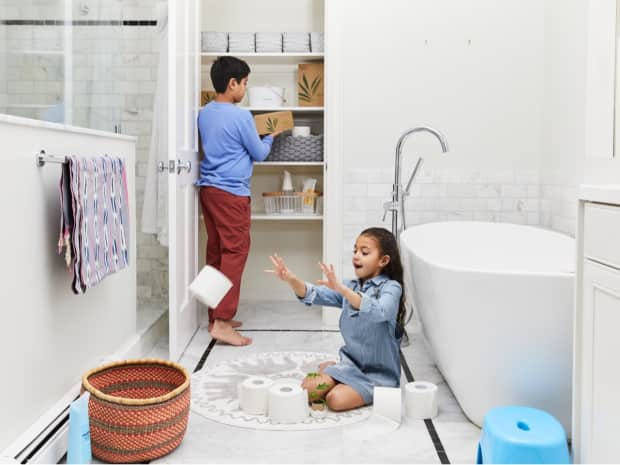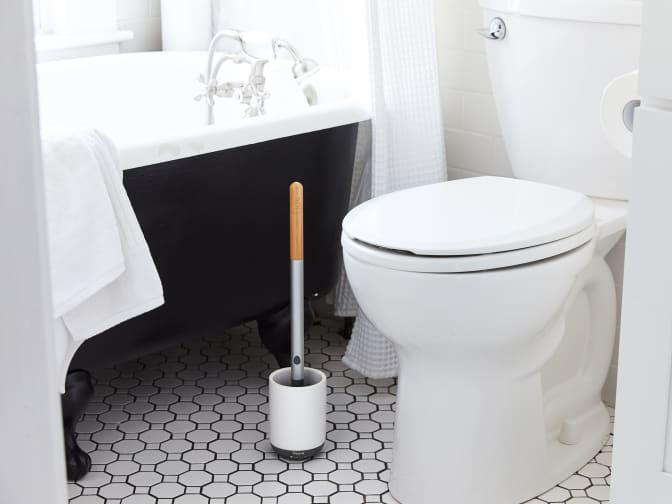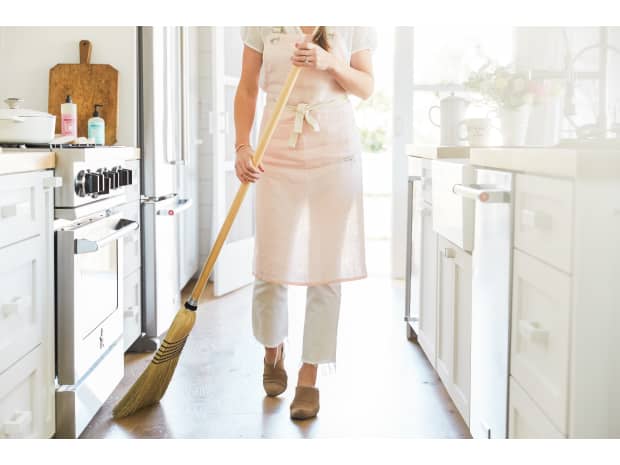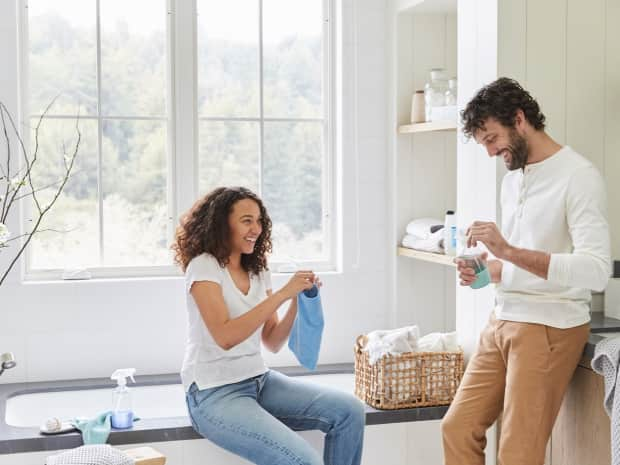
How to Clean a Dishwasher
Your dishwasher deserves a deep clean to keep it working its best. Our guide breaks down how to do the job, naturally.
Read More


Last Updated: February 17, 2022
A clean bathroom doesn’t have to be full of chemicals and bleach smells. Follow our simple guide on how to clean your toilet naturally for germ-free and safe results.
Besides the fact that a clean toilet is a “good hygiene” requisite, there’s a lot of other reasons a clean toilet makes your home just feel cleaner too.
Cleaning your toilet bowl is fairly simple, albeit somewhat gross. Persevere, friends—there’s nothing that beats a sparkling, clean toilet, especially one that’s super clean without the use of harsh chemicals. Because even though our bums made that toilet messy, we shouldn’t subject them to chemicals each time we take a seat on the toilet.
Read on for 4 quick steps we’ve found to safely and effectively clean a toilet with all natural cleaners.

A dirty bathroom is a veritable den for unwelcome visitors including bacteria, viruses, pathogens, and even insects like cockroaches.
If your bathroom is one that’s used by multiple people, it’s even more important to maintain its cleanliness so you can try to prevent the spread of germs from one person to another. Unseen germs and bacteria reside in even the most sparkling of toilet bowls.
Since the toilet seat is touched by everyone, resident or guest, it makes the toilet a perfect way for germs to transfer. In fact, bacteria can remain in the toilet bowl even after multiple flushes.
A clean toilet seat and toilet handle can dramatically reduce the chances of getting a virus from another user and save you from getting a gnarly bacterial infection … or worse.
Already looking for some cleaners after reading those nasty facts? Browse actual Grove members’ 12 favorite natural bathroom cleaners that truly work.
It's recommended to clean your toilet bowl with a dedicated toilet cleaner every week, especially if there are multiple users. Go for a deep clean at least once a month, or shoot for twice a month if multiple people are sharing.

Check out this complete list of more items you may need to clean your toilets:
Remove items that are placed on the back of the toilet seat or in surrounding areas before you start cleaning.
It’s also a good idea to open a window or turn on the exhaust fan for a little ventilation.
Put on your gloves and apply your toilet bowl cleaner to the rim of the toilet, as close as possible.
Be sure to get some liquid up under the rim as well.
Close the lid. Then let it sit and do some magic. Five or 10 minutes is usually a good amount of time.
As the toilet cleaner works its magic inside, start cleaning the exterior of the toilet bowl.
Spray a disinfectant or use a disinfecting wipe on the top and bottom of the toilet lid, as well as the toilet tank and the base of the toilet, and most importantly, the flush handle.
Use a cloth, scrub brush, or wipe to rub away any toilet bowl stains to make sure all surfaces are thoroughly cleaned.
Use a clean, dry microfiber cloth to wipe away water and residue.
Time to go back inside!
Using your toilet brush, scrub the inside of the toilet using the water that has the cleaner still in it. The toilet cleaner should have softened any stuck debris, grime, toilet bowl stains, and spots inside the bowl, making it easier to clean.
Then flush the bowl and rinse the brush in the clean toilet bowl before returning it to its stand. Give your toilet one more flush for good measure.
Grove Tip
While you may think you’re getting a better clean using bleach, many natural cleaners can tackle toilets just as effectively without taking a toll on the environment or on your nose.
If you have a septic system, bleach kills off all the good bacteria you need to break down waste.
The environmental effects of bleach can also range from releasing dangerous toxins (when mixed with other chemicals) into bodies of water to putting wildlife at risk.
For an eco-friendly alternative, consider Seventh Generation's new zero-plastic toilet bowl cleaner powder or other natural, yet effective, toilet cleaners from brands you know and love.
Try using white vinegar and Bon Ami. Remove the water from the bowl with a plunger or by turning off the water valve and flushing. Sprinkle the powder on the stains and douse with vinegar before letting the solution set for about 20 minutes. Then scrub and rinse and repeat as necessary. In the case of hard, stubborn stains, you can try using a pumice stone—preferably one attached to a stick—to clean your toilet bowl. You can also use the finest grade steel wool, but be careful with both methods so you don’t scratch the porcelain.
For maintenance in between deep cleans, use disinfecting wipes on all surfaces. You can also try sprinkling some baking soda in the toilet bowl during the week between cleanings, to help keep it fresh. Use a toilet brush to spread it around and then flush. Easy peasy!
Also known as limescale or mineral deposits, hard water stains sometimes require a different plan of attack than your typical toilet cleaning, as these stains tend to be more stubborn. While you can opt for a commercial descaler, there are a number of natural alternatives you can try — our favorite is a combination of vinegar, baking soda, and elbow grease.
Grove Tip
Try the vinegar and baking soda method above for a homemade toilet bowl cleaner that’s affordable and easy to make with ingredients from the kitchen.
You can also try using distilled white vinegar by itself. Let it soak in the bowl overnight before cleaning and rinsing out.
To clean a truly stained toilet bowl (don’t worry, we won’t ask why it’s so stained), try using distilled white vinegar (Cleaning vinegar also works!) and Bon Ami. Then, follow these steps to remove the stains.
For maintenance in between deep cleans, use disinfecting wipes on all surfaces.
You can also try sprinkling some baking soda in the toilet bowl during the week between cleanings, to help keep it fresh. Use a toilet brush to spread it around and then flush. Easy peasy!
Loving Bon Ami? Find out more uses for this magical product in this review from one of our Grove writers who tried it out in a couple nasty scenarios.
Also known as limescale or mineral deposits, hard water stains sometimes require a different plan of attack than your typical toilet cleaning, as these mineral stains tend to be more stubborn.
Our favorite natural remedy for hard water stains is a paste made from a combination of vinegar and baking soda. Use a 1:1 ratio to start, but add a bit more vinegar in the end to make it foam. Then use your favorite sponge to scrub it in. Let that sit for a bit, maybe 15–20 minutes.
Finally rinse it off with a microfiber cloth. One final wipe with a damp microfiber cloth should get that sparkle back on your throne.

Your dishwasher deserves a deep clean to keep it working its best. Our guide breaks down how to do the job, naturally.

Our step-by-step guide to cleaning this kitchen appliance makes it easy to tackle a tough task — and caked on messes — with natural products.

Our handy guide to everything you need to know to keep you and your family healthy and germ-free.

How to go plastic-free if you're just getting started — and how to level up if you're ready to make a commitment.